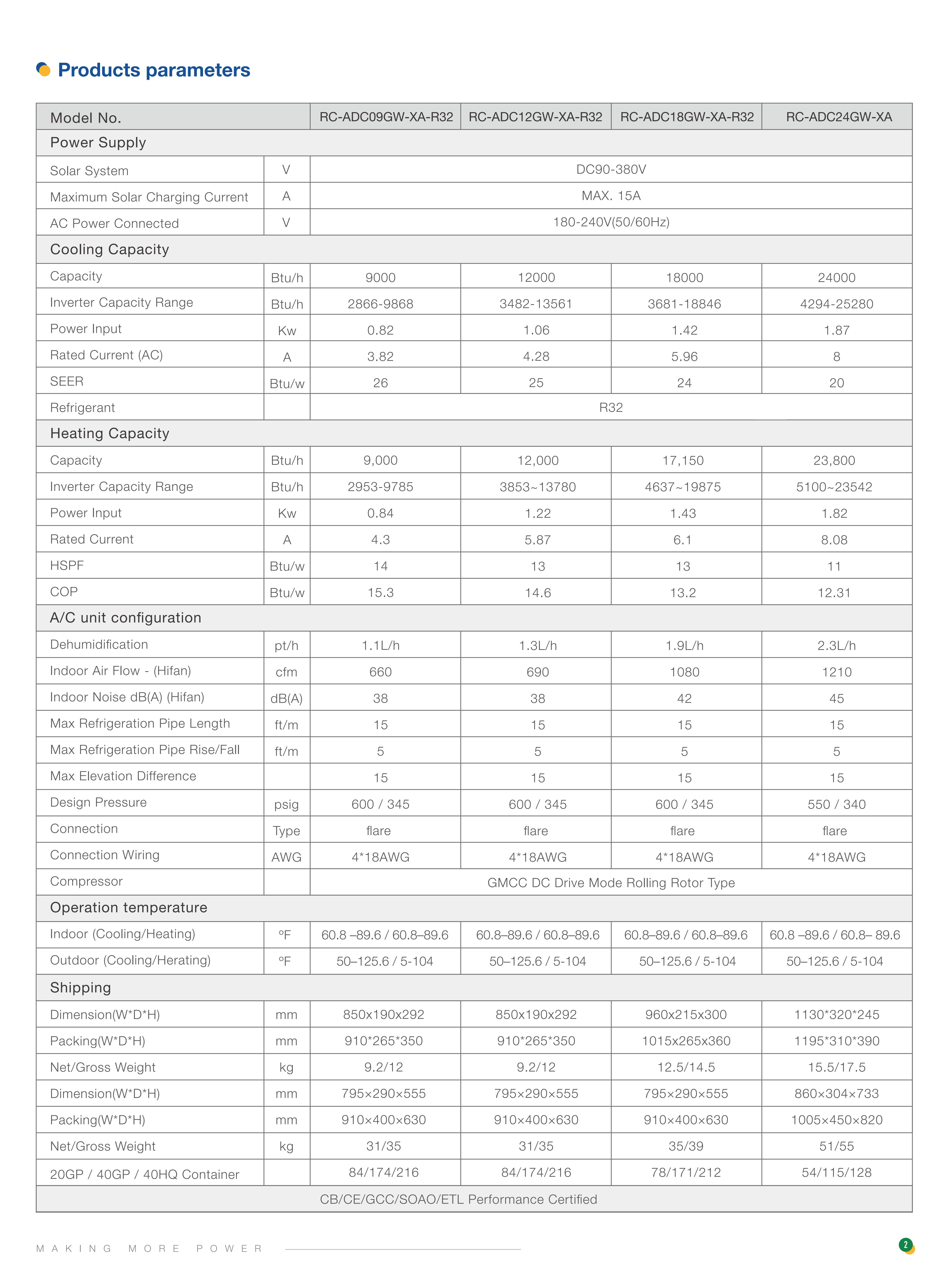It's worth noting that solar-powered air conditioning systems come in various configurations and designs, and the specific details of their operation can vary. It is advisable to consult with a professional or the manufacturer to determine the suitability and installation requirements for your specific needs.
Solar panel voltage:
DC90-380VMaximum Solar Charging Current:
15AAC Power Connected:
180-240V(50/60Hz)Refrigerant:
R32Compressor:
GMCC DC Drive Mode Rolling Rotor TypeConnection:
Flare
Here's a general overview of how a solar-powered air conditioner works:
Solar Panels: The system consists of solar panels that are installed on the roof or suitable location to capture sunlight. These panels are made up of semiconductor materials that convert solar energy into direct current (DC) electricity.
Inverter: The DC electricity generated by the solar panels is then sent to an inverter, which converts it into alternating current (AC) electricity. AC electricity is the standard form of power required to run most electrical appliances.
Air Conditioner Unit: The AC electricity produced by the inverter is used to power the air conditioner unit. The air conditioner unit functions similarly to traditional AC units, utilizing a compressor, condenser, expansion valve, and evaporator to cool and dehumidify the air.
Battery Storage (optional): Some solar-powered air conditioning systems are equipped with battery storage. Any excess electricity generated by the solar panels can be stored in batteries for later use, allowing the air conditioner to operate during periods of low sunlight or at night.
The specific design and components of solar-powered air conditioning systems may vary depending on the manufacturer and model. It's worth noting that solar-powered air conditioners are more commonly used in conjunction with the electrical grid, supplementing power from the solar panels with electricity from the grid when needed.
Regarding the warranty of solar-powered air conditioners, it is typically provided by the manufacturer. The warranty terms and conditions can vary, so it's important to check with the specific manufacturer or supplier of the air conditioner for detailed information about the warranty coverage.

Here's a general overview of how a solar air conditioning system works:
Solar Panels: The system is equipped with solar panels mounted on the roof or in a sunny area. These panels capture sunlight and convert it into direct current (DC) electricity.
DC Power Conversion: The generated DC electricity from the solar panels is fed into an inverter, which converts it into alternating current (AC) electricity. AC power is the standard form of electricity used in most home appliances.
Compressor and Refrigerant: The AC electricity powers the compressor in the air conditioning system. The compressor pressurizes a refrigerant (such as R410A) in the system, which then becomes a high-pressure, high-temperature gas.
Heat Exchange: The hot gas from the compressor passes through a condenser where it releases heat and becomes a high-pressure liquid. This heat exchange process occurs outside the building, typically through outdoor coils.
Throttling Device: The high-pressure liquid refrigerant then flows through a throttling device, which reduces its pressure and temperature.
Evaporator: The cooled and low-pressure refrigerant enters the evaporator, which is located inside the building. As warm air from the room passes over the evaporator coils, the refrigerant absorbs the heat from the air, causing the air to cool down.
Air Handling Unit: The cooled air is circulated back into the room by a fan in the air handling unit, while the heated refrigerant returns to the compressor to repeat the cycle.
In a solar air conditioning system, the DC electricity generated by the solar panels directly powers the operation of the compressor and other components, reducing or even eliminating the need for grid electricity. This results in lower energy consumption and utility costs, as well as a reduced environmental impact compared to conventional air conditioning systems.

The warranty for a solar air conditioner can vary depending the manufacturer and the specific product. Generally, solar air conditioner warranties cover defects in materials and workmanship for a certain period of time. These warranties typically range from 1 year to 10 years or more. It's important to review the warranty terms and conditions provided by the manufacturer to understand what is covered and for how long.
In addition to the overall warranty, certain components such as the solar panels, inverter, compressor, and other parts may have separate warranties with different coverage periods. For example, the solar panels may have a warranty of 25 years or more as they are typically designed to have a long lifespan.
It's recommended to carefully read the warranty documentation provided by the manufacturer, and if you have any specific concerns or questions, you can reach out to the manufacturer or the authorized dealer for clarification.
FAQs:
Q1: Do you support OEM/ODM?
A:Definitely, OEM&ODM service is supported with a certain quantity,including customize logo,package and label;
Q2: What's the production time?
A: The production time is normally 15 working days. but we will always prepare some stocks for popular models.
Q3: Can you provide DDP service?
A:Yes, if you are a personal customer and don't want to deal with the customs, we can provide DDP service to your address.
Q4: What about the warranty and how to claim?
A: Warranty period are 5 years since you receive the product, our professional after-sales team will deal with all warranty issues.